Can Fujian Achieve Carbon Peak and Pollutant Reduction Targets before 2030? Case Study of 3E System in Southeastern China Based on System Dynamics
Abstract
:1. Introduction
2. Materials and Methods
2.1. Data Sources and Processing
2.2. Analysis of Influencing Factors of the 3E System
2.3. STIRPAT Model
2.4. Introduction to 3E System Construction in Fujian Province
2.4.1. System Causality Description
- (1)
- Energy
- (2)
- Economy
- (3)
- Environment
2.4.2. Model Introduction
- (1)
- Population—economy and energy
- (2)
- Economy—environmental pollution
- (3)
- Energy—carbon emissions
- (4)
- Environmental pollution—population
2.4.3. Determination Method of Model Variable Equation
2.5. Scenario Settings
2.5.1. Introduction to Scenario 1
- (1)
- Introduction to economic structure setting
- (2)
- Introduction of per capita GDP
- (3)
- Introduction of pollution generation coefficient
- (4)
- Introduction of per capita energy consumption
- (5)
- Introduction of energy consumption structure
2.5.2. Introduction to Scenario 2
- (1)
- Introduction to economic structure setting
- (2)
- Introduction of per capita GDP
- (3)
- Introduction of pollution generation coefficient
- (4)
- Introduction of per capita energy consumption
- (5)
- Introduction of energy consumption structure
2.5.3. Introduction to Scenario 3
- (1)
- Introduction to industrial structure
- (2)
- Introduction of per capita GDP
- (3)
- Introduction of pollution generation coefficient
- (4)
- Introduction of per capita energy consumption
- (5)
- Introduction of energy consumption structure
2.6. Description of Controlling Objectives for the Target Year (2030)
3. Results and Discussion
3.1. STIRPAT Model
3.2. Fujian Province 3E System Model
3.2.1. Scenario Simulation of per Capita Energy Consumption and Carbon Emission in Fujian Province
3.2.2. Environmental Pollution Scenario Simulation in Fujian Province
3.3. Discussion on EKC of Fujian Province
4. Conclusions and Policy Recommendations
4.1. Conclusions
4.2. Policy Recommendations
- (1)
- Carbon emissions
- (2)
- Pollution discharge
Author Contributions
Funding
Institutional Review Board Statement
Informed Consent Statement
Data Availability Statement
Conflicts of Interest
Appendix A
- (1)
- Auxiliary parameters of COD generation coefficient = WITH LOOKUP (Time, ([(2003,0)-(2035,0.02)], (2003,0.013301), (2004,0.012978), (2005,0.0126351), (2006,0.0108228), (2007,0.008422), (2008,0.00700012), (2009,0.00611385), (2010,0.004861), (2011,0.00734883), (2012,0.00632143), (2013,0.0054639), (2014,0.00483488), (2015,0.00445777), (2016,0.0026625), (2017,0.0024055), (2018,0.0021148), (2019,0.001848)))
- (2)
- Auxiliary parameters of solid waste generation coefficient = WITH LOOKUP (Time, ([(2003,0)-(2035,0.003)], (2003,0.00178111), (2004,0.00208531), (2005,0.00185), (2006,0.000923), (2007,0.000604), (2008,0.00049049), (2009,0.000395), (2010,0.000459), (2011,9.4 × 10−5), (2012,1.5 × 10−5), (2013,6 × 10−6), (2014,3 × 10−6), (2014,3 × 10−6), (2015,1 × 10−6), (2016,1 × 10−6), (2017,2.5 × 10−5), (2018,3.5 × 10−5), (2019,1.4789 × 10−6)))
- (3)
- Auxiliary parameters of sulfur dioxide generation coefficient = WITH LOOKUP (Time, ([(2003,0)-(2035,0.02)], (2003,0.009016), (2004,0.011802), (2005,0.014784), (2006,0.01285), (2007,0.009796), (2008,0.00794), (2009,0.00683), (2010,0.005338), (2011,0.00421), (2012,0.003556), (2013,0.003087), (2014,0.002733), (2015,0.002472), (2016,0.001287), (2017,0.000816), (2018,0.000643), (2019,0.000596)))
- (4)
- Birth rate = WITH LOOKUP (Time, ([(2003,0)-(2035,0.2)], (2003,0.01143), (2004,0.01158), (2005,0.0116), (2006
- (5)
- ,0.012), (2007,0.012), (2008,0.0122), (2009,0.0122), (2010,0.01127), (2011,0.01141), (2012,0.01274), (2013,0.0122), (2014,0.0137), (2015,0.0139), (2016,0.0145), (2017,0.015), (2018,0.0132), (2019,0.0129), (2020,0.00921), (2021,0.0113), (2035,0.0122)))
- (6)
- Births = Population * Birth rate
- (7)
- Carbon emissions = (Raw coal consumption * 0.499 + Crude oil consumption * 0.838 + Natural gas consumption * 0.59)
- (8)
- Carbon emissions per unit of GDP = Carbon emissions/GDP * 10,000
- (9)
- COD discharge = Polluting GDP2 * COD generation coefficient
- (10)
- COD generation coefficient = IF THEN ELSE (Time ≤ 2019,Auxiliary parameters of COD generation coefficient, 0.001848 * 0.95^(Time − 2019))
- (11)
- Coefficient of Impact of pollution emissions on mortality = 1 × 10−20
- (12)
- Crude oil consumption = Total energy consumption * Crude oil proportion/1.4286
- (13)
- Crude oil proportion = WITH LOOKUP (Time, ([(2003,0)-(2035,0.3)], (2003,0.245), (2004,0.251), (2005,0.238), (2006,0.225), (2007,0.228), (2008,0.201), (2009,0.195), (2010,0.248), (2011,0.258), (2012,0.235), (2013,0.233), (2014,0.258), (2015,0.248), (2016,0.238), (2017,0.241), (2018,0.225), (2019,0.23), (2035,0.203)))
- (14)
- Deaths = Population * Mortality rate
- (15)
- FINAL TIME = 2035
- (16)
- GDP = Population * Per capita GDP * 10,000
- (17)
- GDP of primary industry = GDP * Proportion of primary industry
- (18)
- GDP of secondary industry = GDP * Proportion of secondary industry
- (19)
- GDP of tertiary industry = GDP * Proportion of tertiary industry
- (20)
- Impact of pollution emissions on mortality = Pollution emission intensity * Coefficient of Impact of pollution emissions on mortality
- (21)
- INITIAL TIME = 2003
- (22)
- Mortality rate = Natural mortality + Impact of pollution emissions on mortality
- (23)
- Natural gas consumption = Total energy consumption * Natural gas proportion/1.2143
- (24)
- Natural gas proportion = WITH LOOKUP (Time, ([(2003,0)-(2035,0.08)], (2003,0), (2004,0.002), (2005,0.001), (2006,0.001), (2007,0.001), (2008,0.003), (2009,0.014), (2010,0.042), (2011,0.046), (2012,0.048), (2013,0.058), (2014,0.057), (2015,0.051), (2016,0.054), (2017,0.053), (2018,0.051), (2019,0.048), (2035,0.042)))
- (25)
- Natural mortality = WITH LOOKUP (Time, ([(2003,0)-(2035,0.01)], (2003,0.00558), (2004,0.00562), (2005,0.00562), (2006,0.00575), (2007,0.0059), (2008,0.0059), (2009,0.006), (2010,0.00516), (2011,0.0052), (2012,0.00573), (2013,0.00601), (2014,0.0062), (2015,0.0061), (2016,0.0062), (2017,0.0062), (2018,0.0062), (2019,0.0061), (2020,0.00513), (2021,0.0062), (2035,0.0061)))
- (26)
- Non-fossil energy consumption = Total energy consumption * “Non-fossil energy proportion”
- (27)
- Non-fossil energy proportion = 1 − Crude oil proportion − Raw coal proportion − Natural gas proportion
- (28)
- Per capita energy consumption = IF THEN ELSE(Time ≤ 2019,263.63 * LN (Time) − 2002.9,3.67957 + (Time − 2019) * EXP (−0.0015 * Time))
- (29)
- Per capita GDP = 7.7728e + 08 + −778,598 * Time + 194.98 * Time^2
- (30)
- Polluting GDP = 0.1 * GDP of primary industry + 0.9 * GDP of secondary industry + 0.1 * GDP of tertiary industry
- (31)
- Polluting GDP2 = Polluting GDP/10,000
- (32)
- Pollution emission intensity = 0.049 * COD discharge + 0.108 * Sulfur dioxide emissions + 0.843 * Solid waste discards
- (33)
- Population = INTEG (Births-Deaths,3502)
- (34)
- Proportion of primary industry = WITH LOOKUP (Time,([(2003,0)-(2035,0.2)], (2003,0.136423), (2004,0.13355), (2005,0.123534), (2006,0.1109), (2007,0.102), (2008,0.1002), (2009,0.0892), (2010,0.0846), (2011,0.0832), (2012,0.0806), (2013,0.0775), (2014,0.0744), (2015,0.0721), (2016,0.072447), (2017,0.0654), (2018,0.0615), (2019,0.0613), (2035,0.05)))
- (35)
- Proportion of secondary industry = WITH LOOKUP (Time, ([(2003,0)-(2035,0.6)], (2003,0.4659), (2004,0.4794), (2005,0.4825), (2006,0.4859), (2007,0.4848), (2008,0.4927), (2009,0.4935), (2010,0.5135), (2011,0.5199), (2012,0.521378), (2013,0.5245), (2014,0.5278), (2015,0.5121), (2016,0.4959), (2017,0.4813), (2018,0.48717), (2019,0.47406), (2035,0.431)))
- (36)
- Proportion of tertiary industry = 1 − Proportion of primary industry − Proportion of secondary industry
- (37)
- Raw coal consumption = Total energy consumption * Raw coal proportion/0.7143
- (38)
- Raw coal proportion = WITH LOOKUP (Time, ([(2003,0)-(2035,0.7)], (2003,0.614), (2004,0.638), (2005,0.594), (2006,0.598), (2007,0.629), (2008,0.626), (2009,0.655), (2010,0.554), (2011,0.62), (2012,0.571), (2013,0.568), (2014,0.53), (2015,0.499), (2016,0.429), (2017,0.451), (2018,0.473), (2019,0.484), (2035,0.427)))
- (39)
- SAVEPER = TIME STEP
- (40)
- The frequency with which output is stored.
- (41)
- Solid waste discards = Polluting GDP2 * Solid waste generation coefficient
- (42)
- Solid waste generation coefficient = IF THEN ELSE (Time ≤ 2019,Auxiliary parameters of solid waste generation coefficient, 1.4789 × 10−6 * 0.9^(Time − 2019))
- (43)
- Sulfur dioxide emissions = Polluting GDP2 * Sulfur dioxide generation coefficient
- (44)
- Sulfur dioxide generation coefficient = IF THEN ELSE (Time ≤ 2019, Auxiliary parameters of sulfur dioxide generation coefficient, 0.000596 * 0.9^(Time − 2019))
- (45)
- TIME STEP = 1
- (46)
- Total energy consumption = Population * Per capita energy consumption * 10,000
References
- Yang, H.; Li, X.; Ma, L.; Li, Z. Using system dynamics to analyse key factors influencing China’s energy-related CO2 emissions and emission reduction scenarios. J. Clean. Prod. 2021, 320, 128811. [Google Scholar] [CrossRef]
- Roelfsema, M.; Soest, H.V.; Harmsen, M.; Vuuren, D.V.; Bertram, C.; Elzen, M.D.; Iacobuta, G.; Krey, V.; Kriegler, E.; Luderer, G. Taking stock of national climate policies to evaluate implementation of the Paris Agreement. Nat. Commun. 2020, 11, 2096. [Google Scholar] [CrossRef]
- Zuo, Y.; Shi, Y.-l.; Zhang, Y.-z. Research on the Sustainable Development of an Economic-Energy-Environment (3E) System Based on System Dynamics (SD): A Case Study of the Beijing-Tianjin-Hebei Region in China. Sustainability 2017, 9, 1727. [Google Scholar] [CrossRef]
- IPCC AR6 Synthesis Report: Climate Change 2022. Available online: https://www.ipcc.ch/report/sixth-assessment-report-cycle/ (accessed on 21 April 2022).
- GOFJP Issued by Fujian Provincial People’s Government Fujian Province National Economic and Social Development of the Fourteenth Five-Year Plan and Notice on the Outline of the Vision for 2035. Available online: https://www.fujian.gov.cn/zwgk/zfxxgk/szfwj/szfgz/202103/t20210319_5552893.htm (accessed on 21 March 2021).
- Zhang, S.; Hu, T.; Li, J.; Cheng, C.; Song, M.; Xu, B.; Baležentis, T. The effects of energy price, technology, and disaster shocks on China’s Energy-Environment-Economy system. J. Clean. Prod. 2019, 207, 204–213. [Google Scholar] [CrossRef]
- Groncki, P.J.; Marcuse, W. Brookhaven Integrated Energy/Economy Modeling System and Its Use in Conservation Policy Analysis; Brookhaven National Lab.: Upton, NY, USA, 1982; pp. 535–555.
- Forrest, J.W. Industrail Dynamics; MIT Press: Cambridge, MA, USA, 1964. [Google Scholar]
- Forrest, J.W. Urban Dynamics; MIT Press: Cambridge, MA, USA, 1969. [Google Scholar]
- Forrest, J.W. World Dynamics; Wright-Allen Press: Cambridge, MA, USA, 1971. [Google Scholar]
- Isa, S.H.; Ramlee, M.N.A.; Lola, M.S.; Ikhwanuddin, M.; Azra, M.N.; Abdullah, M.T.; Zakaria, S.; Ibrahim, Y. A system dynamics model for analysing the eco-aquaculture system of integrated aquaculture park in Malaysia with policy recommendations. Environ. Dev. Sustain. 2021, 23, 511–533. [Google Scholar] [CrossRef]
- Khajehpour, H.; Ahmady, M.A.; Hosseini, S.A.; Mashayekhi, A.N.; Maleki, A. Environmental policy-making for Persian Gulf oil pollution:A future study based on system dynamics modeling. Energy Sources Part B Econ. Plan. Policy 2016, 12, 17–23. [Google Scholar] [CrossRef]
- Xiao, S.; Dong, H.; Geng, Y.; Tian, X.; Li, H. Policy impacts on Municipal Solid Waste management in Shanghai: A system dynamics model analysis. J. Clean. Prod. 2020, 262, 121366. [Google Scholar] [CrossRef]
- Guo, X.; Ren, D.; Guo, X. A system dynamics model of China’s electric power structure adjustment with constraints of PM10 emission reduction. Environ. Sci. Pollut. Res. 2018, 25, 17540–17552. [Google Scholar] [CrossRef]
- Dai, D.; Sun, M.; Lv, X.; Hu, J.; Zhang, H.; Xu, X.; Lei, K. Comprehensive assessment of the water environment carrying capacity based on the spatial system dynamics model, a case study of Yongding River Basin in North China. J. Clean. Prod. 2022, 344, 131137. [Google Scholar] [CrossRef]
- Wang, G.; Xiao, C.; Qi, Z.; Meng, F.; Liang, X. Development tendency analysis for the water resource carrying capacity based on system dynamics model and the improved fuzzy comprehensive evaluation method in the Changchun city, China. Ecol. Indic. 2021, 122, 107232. [Google Scholar] [CrossRef]
- Yang, J.; Strokal, M.; Kroeze, C.; Wang, M.; Wang, J.; Wu, Y.; Bai, Z.; Ma, L. Nutrient losses to surface waters in Hai He basin: A case study of Guanting reservoir and Baiyangdian lake. Agric. Water Manag. 2019, 213, 62–75. [Google Scholar] [CrossRef]
- Collatto, D.C.; Lacerda, D.P.; Morandi, M.; Piran, F.S. Environmental externalities in broiler production: An analysis based on system dynamics. J. Clean. Prod. 2019, 209, 190–199. [Google Scholar]
- Jin, E.; Mendis, G.P.; Sutherland, J.W. Integrated sustainability assessment for a bioenergy system: A system dynamics model of switchgrass for cellulosic ethanol production in the U.S. midwest. J. Clean. Prod. 2019, 234, 503–520. [Google Scholar] [CrossRef]
- Navarro, A.; Moreno, R.; Jimenez-Alcazar, A.; Tapiador, F.J. Coupling population dynamics with earth system models: The POPEM model. Environ. Sci. Pollut. Res. Int. 2019, 26, 3184–3195. [Google Scholar] [CrossRef] [PubMed]
- Benvenutti, L.M.; Uriona-Maldonado, M.; Campos, L. The impact of CO2 mitigation policies on light vehicle fleet in Brazil. Energy Policy 2019, 126, 370–379. [Google Scholar] [CrossRef]
- Sun, L.; Niu, D.; Wang, K.; Xu, X. Sustainable development pathways of hydropower in China: Interdisciplinary qualitative analysis and scenario-based system dynamics quantitative modeling. J. Clean. Prod. 2020, 287, 125528. [Google Scholar] [CrossRef]
- Watabe, A.; Leaver, J.; Ishida, H.; Shafiei, E. Impact of low emissions vehicles on reducing greenhouse gas emissions in Japan. Energy Policy 2019, 130, 227–242. [Google Scholar] [CrossRef]
- Wang, M.; Che, Y.; Yang, K.; Wang, M.; Xiong, L.; Huang, Y. A local-scale low-carbon plan based on the STIRPAT model and the scenario method: The case of Minhang District, Shanghai, China. Energy Policy 2011, 39, 6981–6990. [Google Scholar] [CrossRef]
- Azevedo, V.G.; Sartori, S.; Campos, L.M.S. CO2 emissions: A quantitative analysis among the BRICS nations. Renew. Sustain. Energy Rev. 2018, 81, 107–115. [Google Scholar] [CrossRef]
- Dietz, T.; Rosa, E.A. Effects of population and affluence on CO2 emissions. Proc. Natl. Acad. Sci. USA 1997, 94, 175. [Google Scholar] [CrossRef]
- Chu, Z.; Wu, Y.; Zhou, A.; Huang, W.C. Analysis of influence factors on municipal solid waste generation based on the multivariable adjustment. Environ. Prog. Sustain. Energy 2016, 35, 1629–1633. [Google Scholar] [CrossRef]
- He, Y.; Lin, K.; Liao, N.; Chen, Z.; Rao, J. Exploring the spatial effects and influencing factors of PM2.5 concentration in the Yangtze River Delta Urban Agglomerations of China. Atmos. Environ. 2022, 268, 118805. [Google Scholar] [CrossRef]
- Li, L.G.I.; Zhang, P.Y.; Liu, W.X.; Jing, L.I.; Wang, L.F. Spatial-temporal evolution characteristics and influencing factors of county-scale environmental pollution in Jilin Province, Northeast China. Chin. J. Appl. Ecol. 2019, 30, 2361–2370. [Google Scholar]
- Behera, S.R.; Dash, D.P. The effect of urbanization, energy consumption, and foreign direct investment on the carbon dioxide emission in the SSEA (South and Southeast Asian) region. Renew. Sustain. Energy Rev. 2017, 70, 96–106. [Google Scholar] [CrossRef]
- Moutinho, V.; Moreira, A.C.; Silva, P.M. The driving forces of change in energy-related CO2 emissions in Eastern, Western, Northern and Southern Europe: The LMDI approach to decomposition analysis. Renew. Sustain. Energy Rev. 2015, 50, 1485–1499. [Google Scholar] [CrossRef]
- Xiao, B.; Niu, D.; Wu, H. Exploring the impact of determining factors behind CO2 emissions in China: A CGE appraisal. Sci. Total Environ. 2017, 581–582, 559–572. [Google Scholar] [CrossRef]
- Lin, B.; Benjamin, N.I. Influencing factors on carbon emissions in China transport industry. A new evidence from quantile regression analysis. J. Clean. Prod. 2017, 150, 175–187. [Google Scholar] [CrossRef]
- Tan, S.T.; Ho, W.S.; Hashim, H.; Lee, C.T.; Taib, M.R.; Ho, C.S. Energy, economic and environmental (3E) analysis of waste-to-energy (WTE) strategies for municipal solid waste (MSW) management in Malaysia. Energy Convers. Manag. 2015, 102, 111–120. [Google Scholar] [CrossRef]
- Yejing, Z. A Quantitative Study on Environmental Carrying Capacity and Ecological Compensation Standard in Urban Environmental Planning. Ph.D. Thesis, Huazhong University of Science and Technology, Wuhan, China, 2017. [Google Scholar]
- Wu, D.; Ning, S. Dynamic assessment of urban economy-environment-energy system using system dynamics model: A case study in Beijing. Environ. Res. 2018, 164, 70. [Google Scholar] [CrossRef]
- Liu, Z.; Guan, D.; Wei, W.; Davis, S.J.; Ciais, P.; Bai, J.; Peng, S.; Zhang, Q.; Hubacek, K.; Marland, G. Reduced carbon emission estimates from fossil fuel combustion and cement production in China. Nature 2015, 524, 335–338. [Google Scholar] [CrossRef]
- Qin, C. A Study of the “Energy-Environment-Economy” System in China Based on System Dynamics Modelling. Master’s Thesis, Harbin Institute of Technology, Harbin, China, 2015. [Google Scholar]
- Hua, L.; Jing-wen, W.; Bang-zhu, Z. Residential energy consumption in US: 30 years micro-survey data. China Popul. Resour. Environ. 2017, 27, 8. [Google Scholar]
- Wang, Y.; Zhang, C.; Lu, A.; Li, L.; He, Y.; Tojo, J.; Zhu, X. A disaggregated analysis of the environmental Kuznets curve for industrial CO2 emissions in China. Appl. Energy 2017, 190, 172–180. [Google Scholar] [CrossRef]
- Zheng, X.; Wei, C.; Qin, P.; Guo, J.; Yu, Y.; Song, F.; Chen, Z. Characteristics of residential energy consumption in China: Findings from a household survey. Energy Policy 2014, 75, 126–135. [Google Scholar] [CrossRef]
- Panayotou, T. Empirical Tests and Policy Analysis of Environmental Degradation at Different Stages of Economic Development; International Labour Office: Geneva, Switzerland, 1993; Chapter 4. [Google Scholar]
- Fujian Provincial Bureau of Statistics. Statistical Yearbook of Fujian Province. Available online: https://tjj.fujian.gov.cn/xxgk/ndsj/ (accessed on 23 September 2021).
- A’zhong, Y.; Hang, Z. Study on Non-Linear Effect of Economic Growth on Environmental Pollution: Retest Based on Semi Parametric Spatial Model. Ecol. Econ. 2022, 38, 9. [Google Scholar]
- Wen-ping, W.; Tian-tian, Z. Eco-economic system of the Chinese industry. J. Southeast Univ. Philos. Soc. Sci. 2015, 17, 73–78. [Google Scholar]
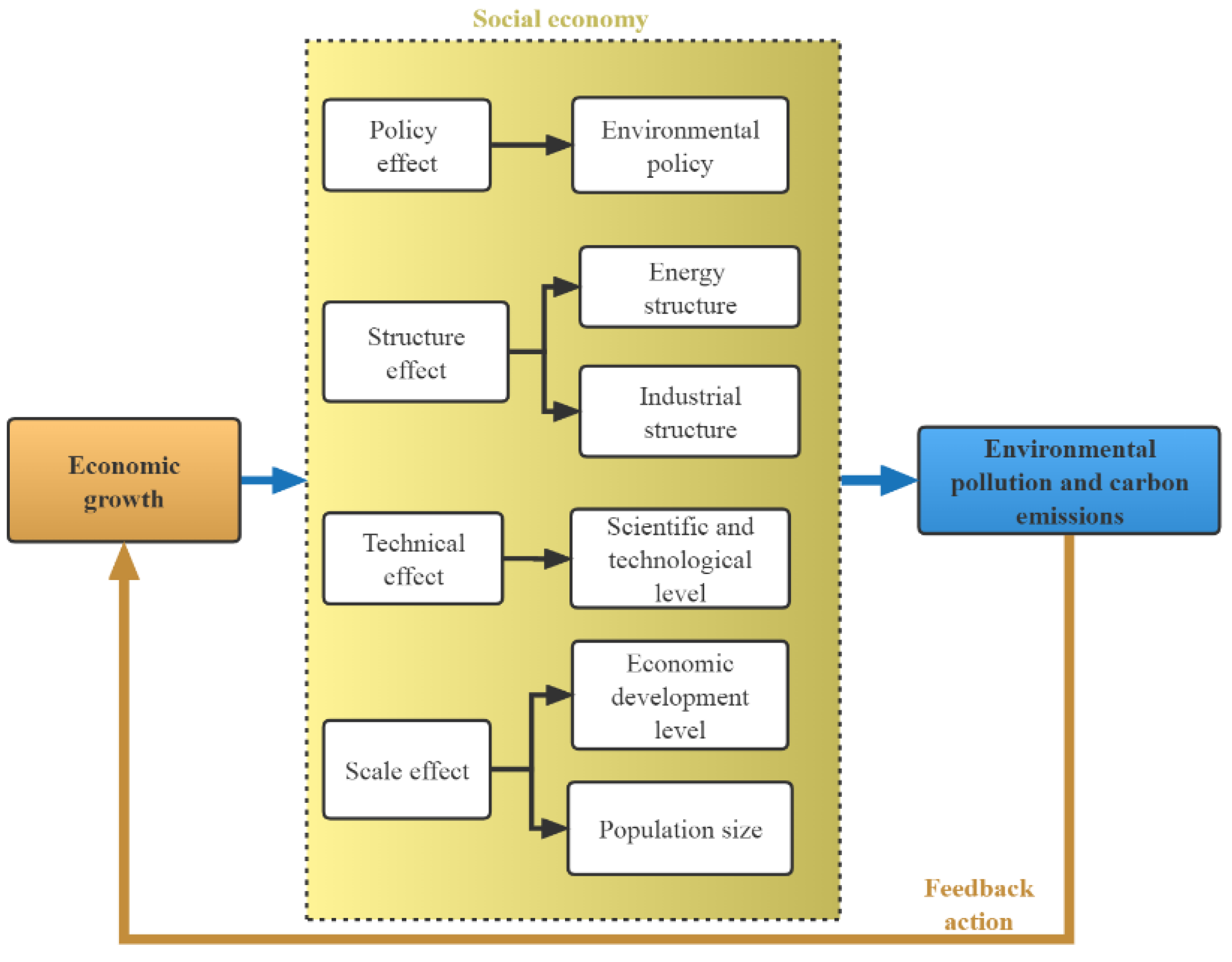
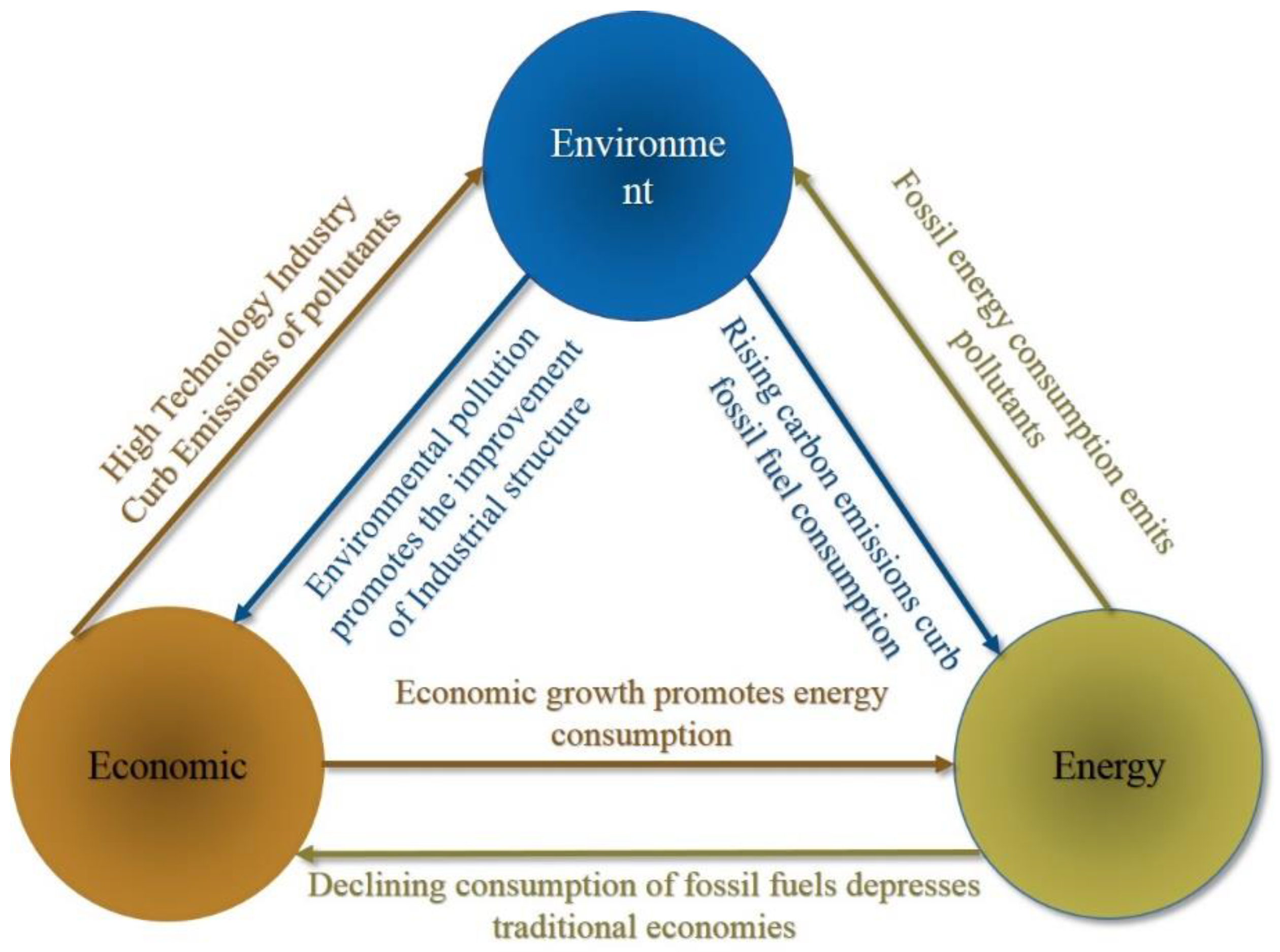
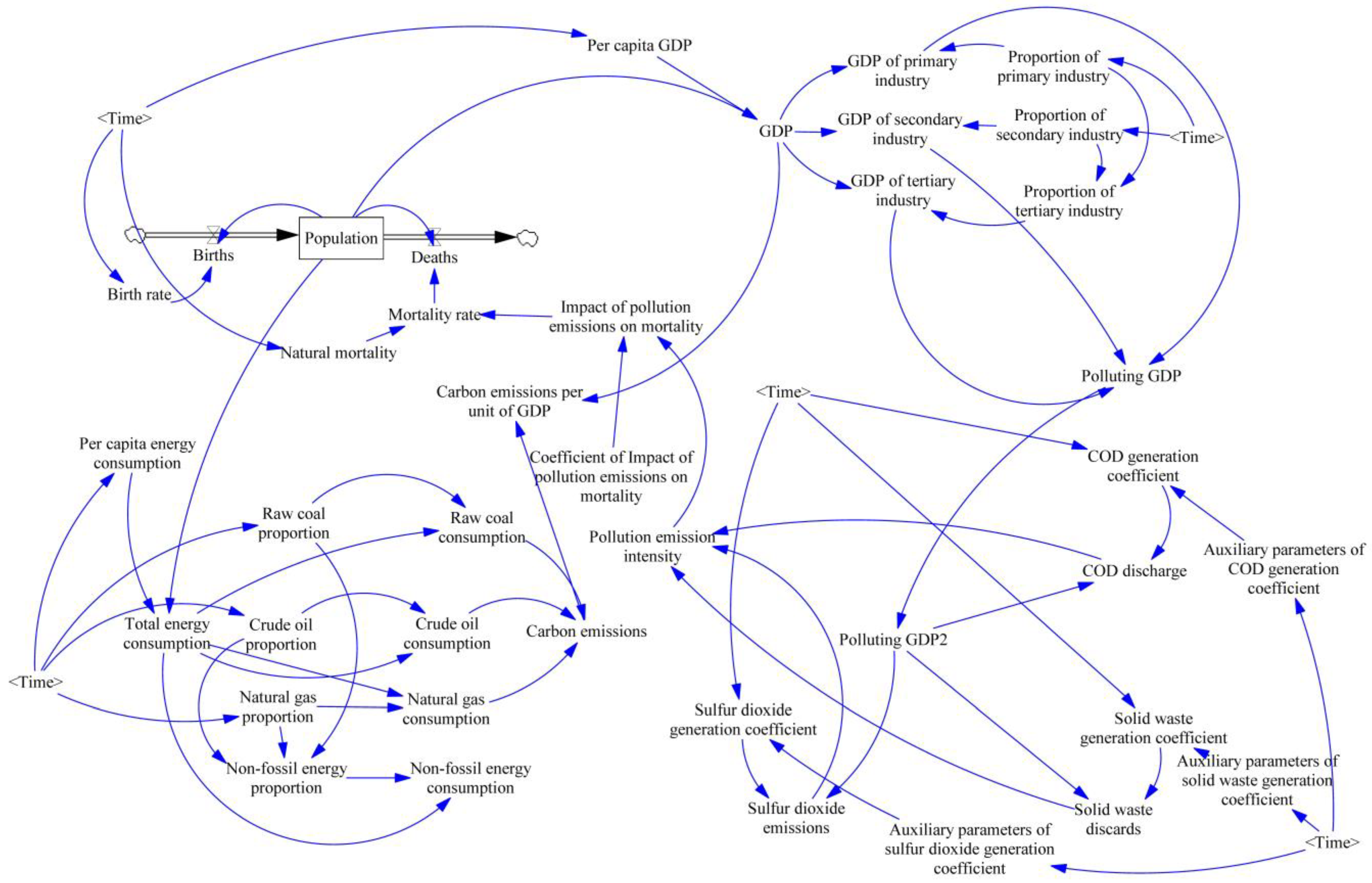

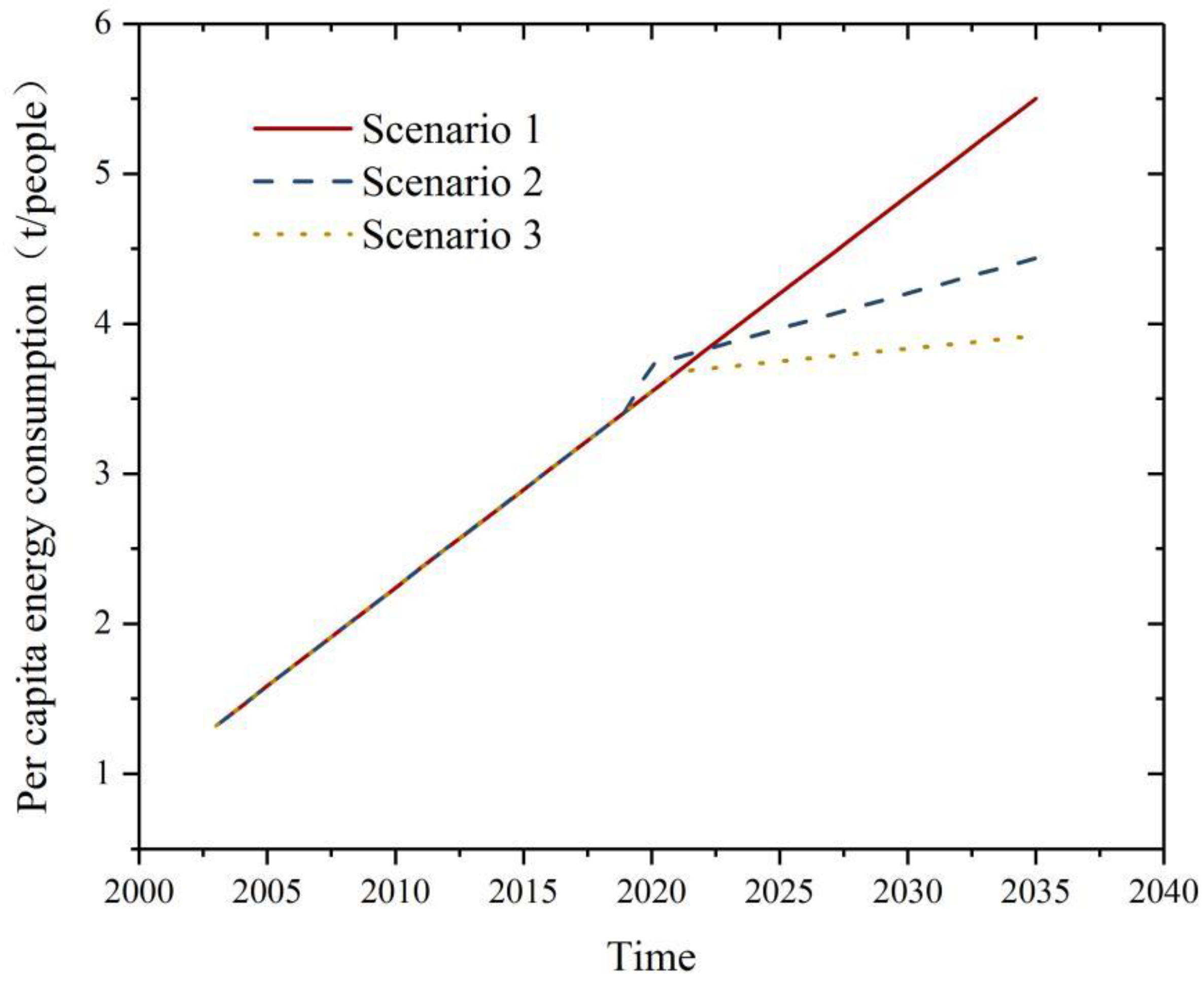
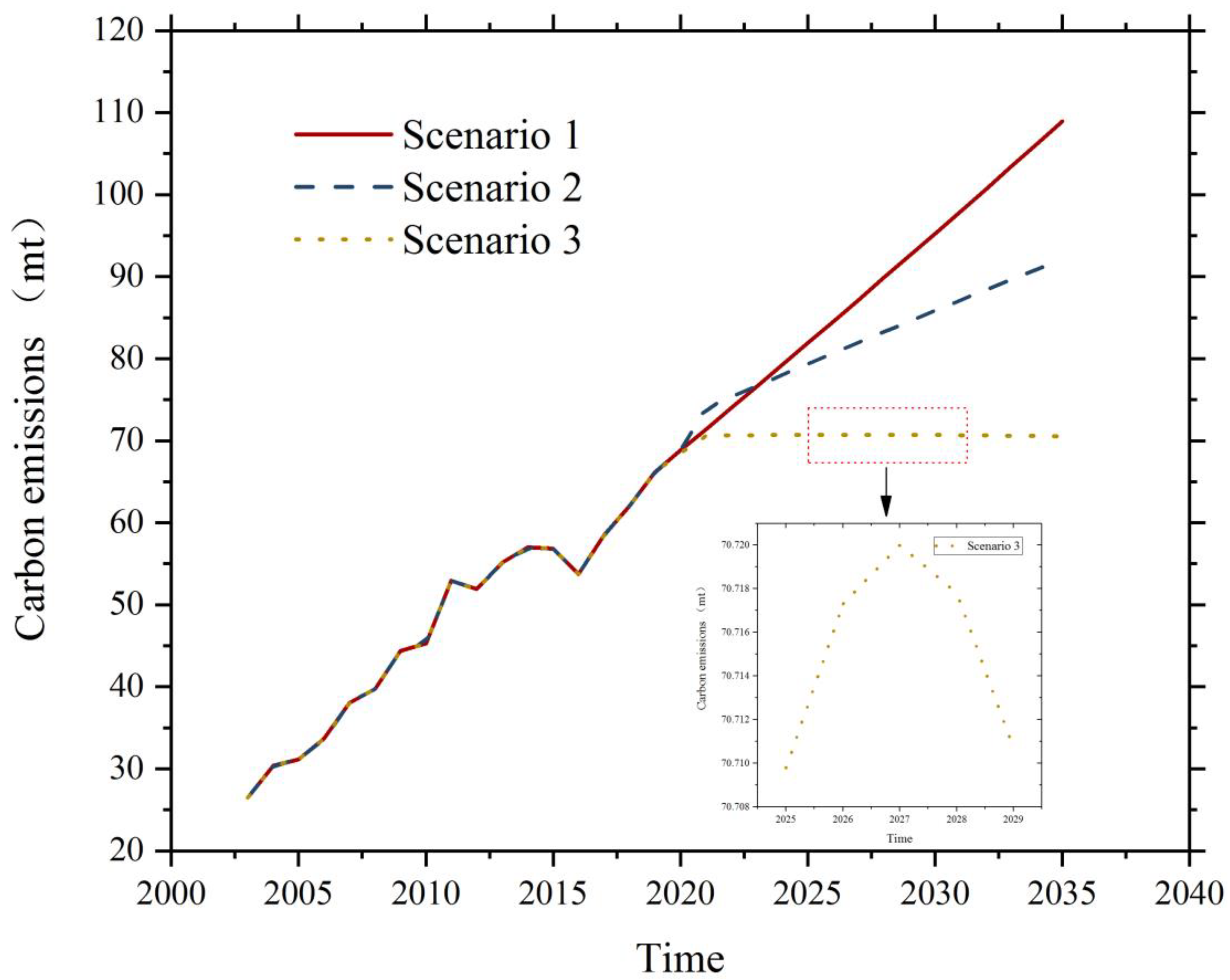
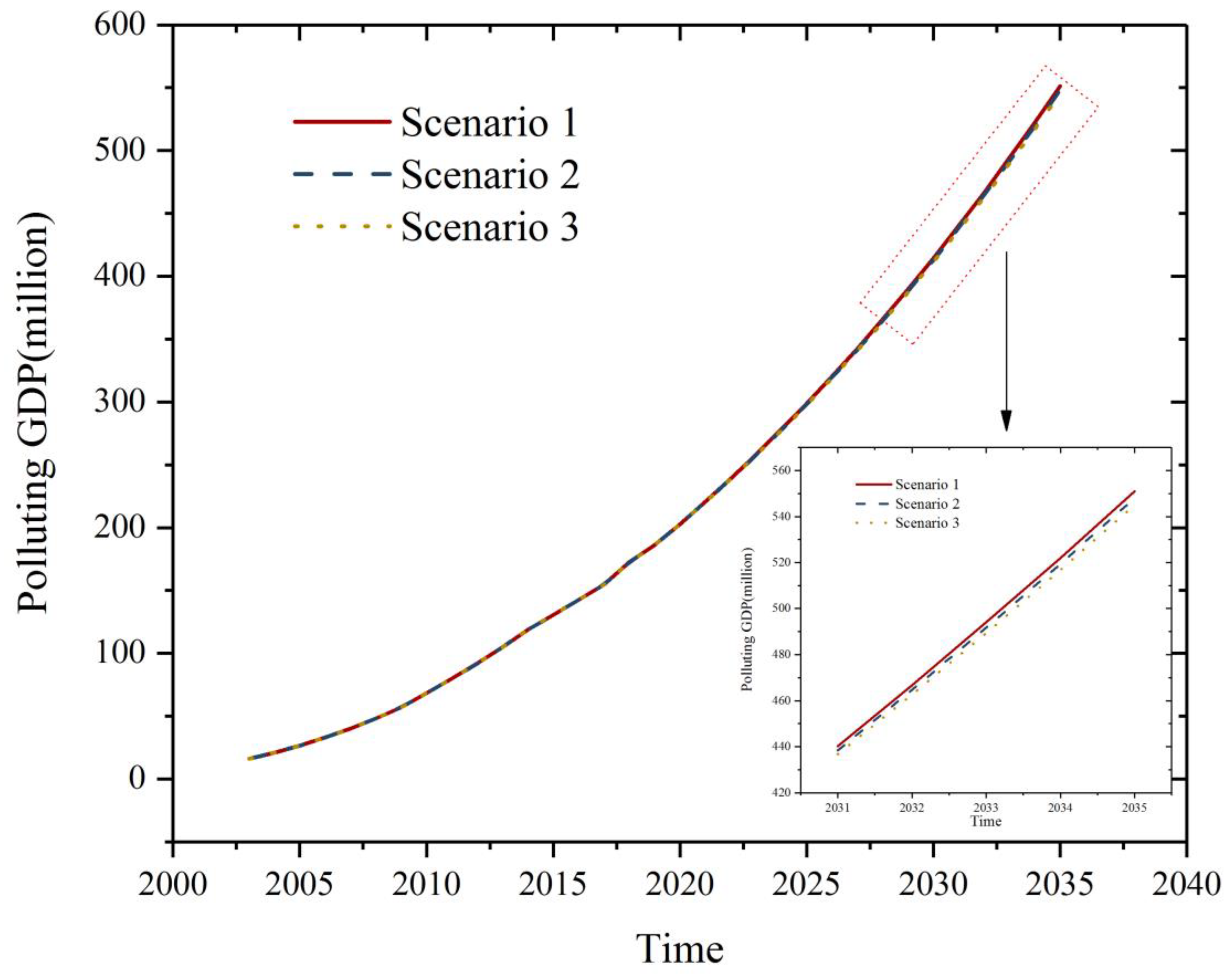


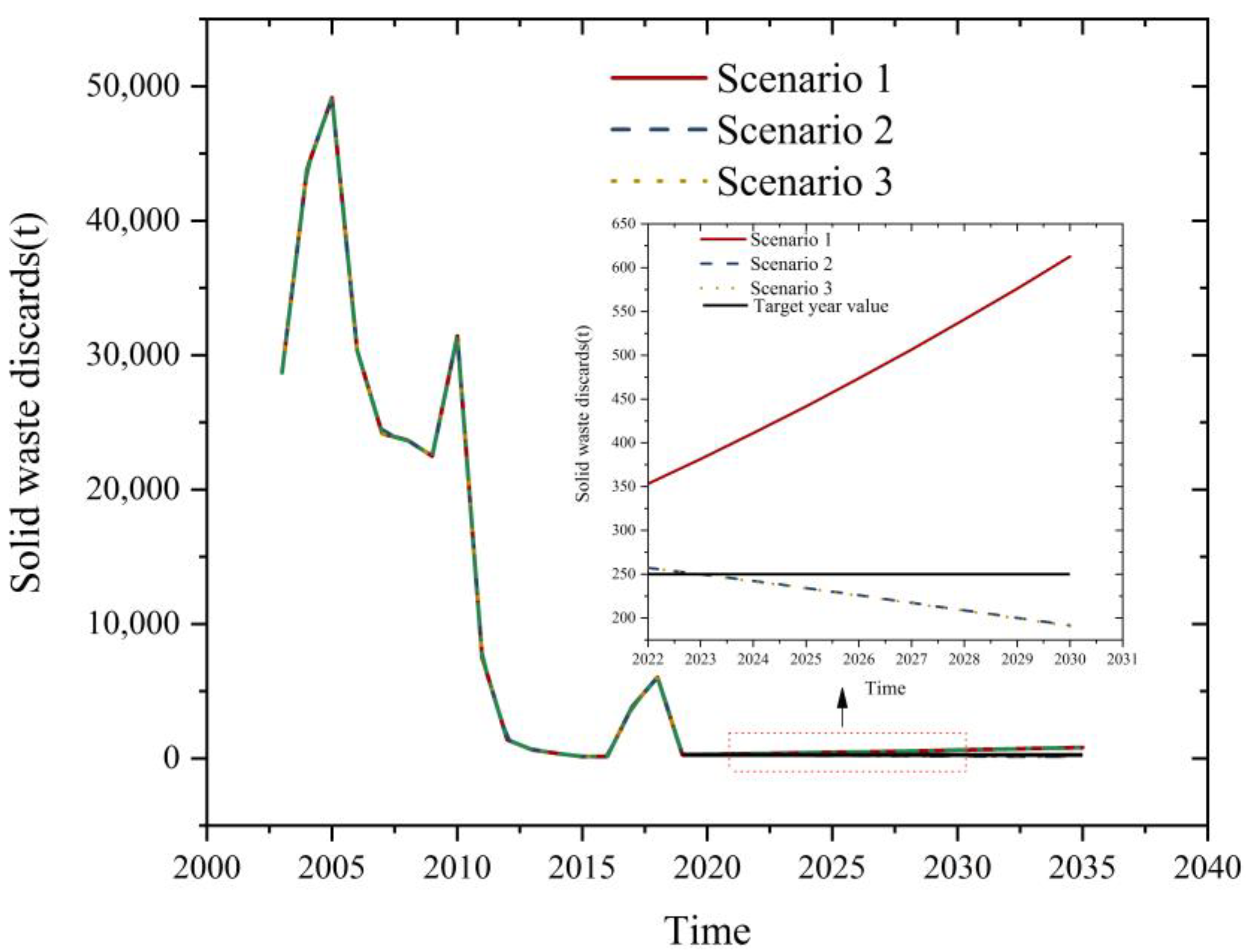
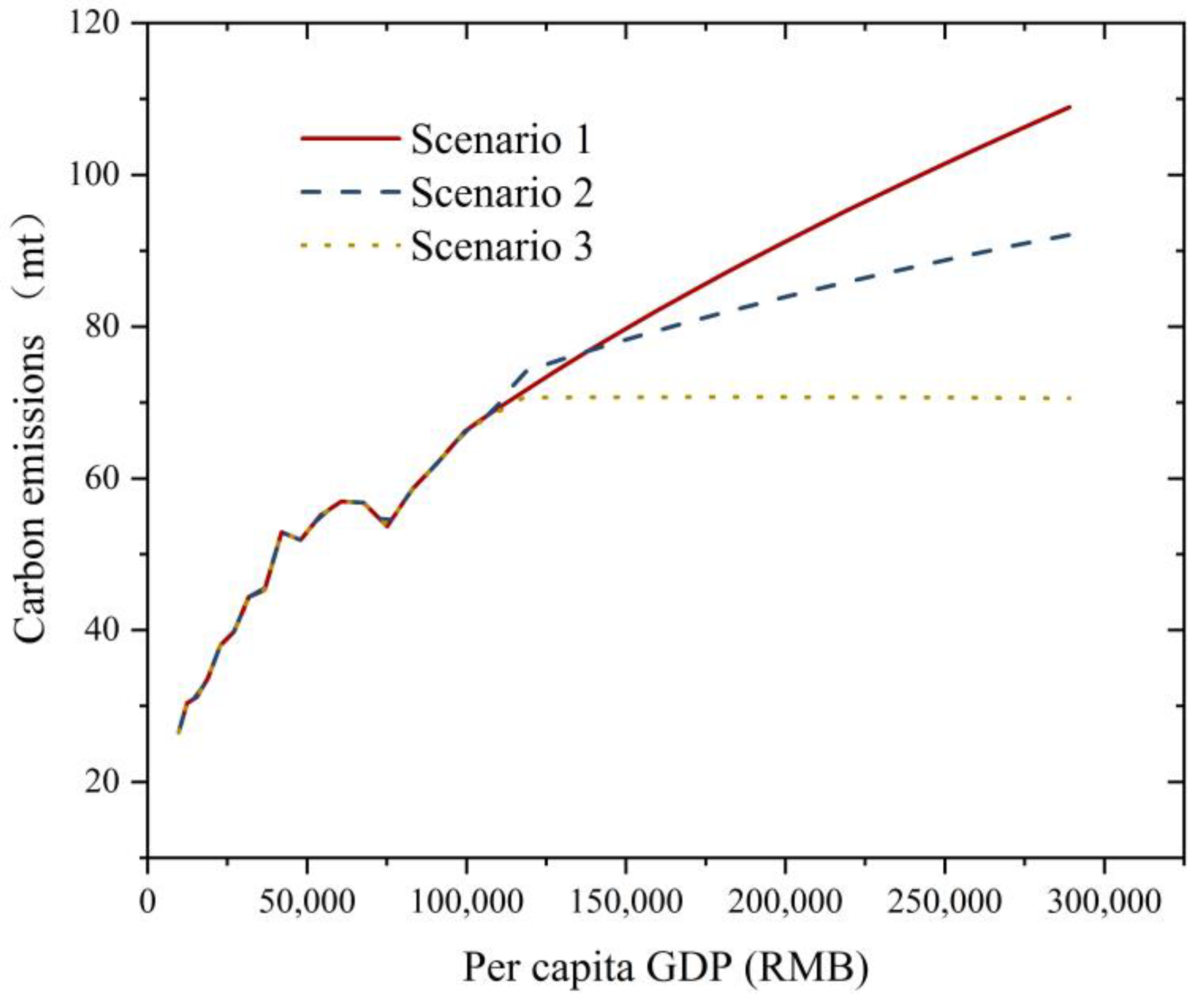
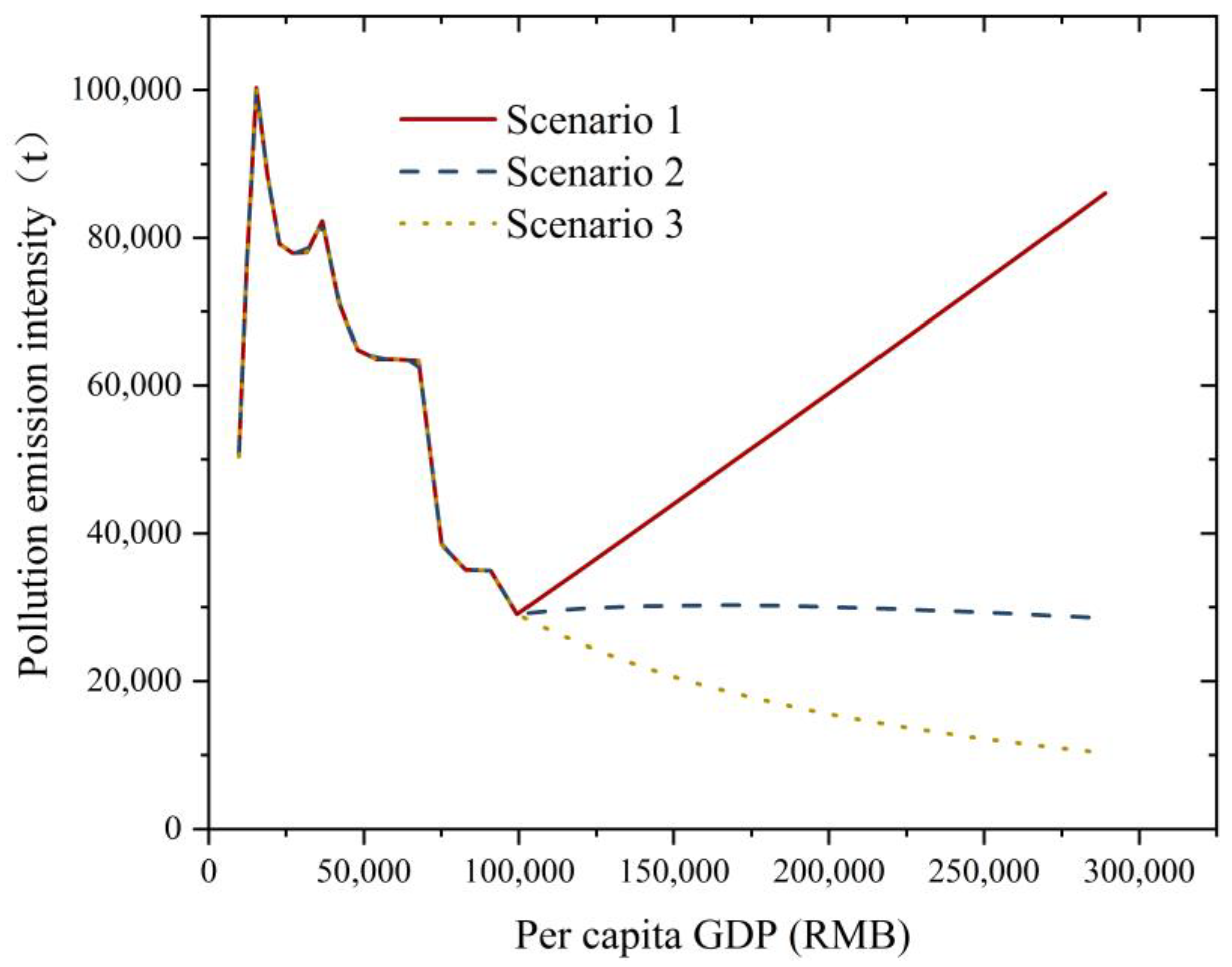
| No. | Research | Region | Method | Carbon Emission/Environmental Pollution | Main Influencing Factors |
|---|---|---|---|---|---|
| 1 | [27] | China | Multivariable adjustment | environmental pollution | urban population, GDP per capita disposable income of urban residents solid waste treatment rate |
| 2 | [28] | China | STIRPAT | environmental pollution | population density energy intensity foreign direct investment |
| 3 | [29] | China | STIRPAT | environmental pollution | level of regional economic development urbanization level agricultural production |
| 4 | [30] | Asian | STIRPAT | carbon emission | urbanization, primary energy consumption, foreign direct investment |
| 5 | [31] | Europe | Index decomposition analysis | carbon emission | carbon intensity energy mix (structure) energy intensity average renewable capacity productivity change in capacity of renewable energy per capita |
| 6 | [32] | China | Computable general equilibrium model | carbon emission | energy efficiency energy structure industrial structure |
| 7 | [33] | China | Quantile regression analysis | carbon emission | GDP, energy intensity carbon intensity urbanization |
| Variable Category | Variable Name | Unit | Data Source (2004–2021) |
|---|---|---|---|
| Water pollution | Chemical oxygen demand discharge (COD) | Ten thousand tons | Statistical Yearbook of Fujian Province |
| Atmospheric pollution | Sulfur dioxide emission (SO2) | Ten thousand tons | Statistical Yearbook of Fujian Province |
| Carbon emissions | Carbon dioxide emission (CO2) | Ten thousand tons | Calculated indirectly from the China Carbon Accounting Database |
| Solid waste pollution | Industrial solid waste discharge (ISW) | Ten thousand tons | Statistical Yearbook of Fujian Province |
| Economic development level | GDP per capita | CNY | Calculated indirectly by Fujian Statistical Yearbook |
| Population size | Population density (PD) | People/km2 | Calculated indirectly by Fujian Statistical Yearbook |
| Urbanization level (UL) | % | Calculated indirectly by Fujian Statistical Yearbook | |
| Scientific and technological level | R&D expenditure/GDP (TS) | % | Statistical Yearbook of Fujian Province |
| Economic structure | The GDP share of secondary Industry (IS) | % | Calculated indirectly by Fujian Statistical Yearbook |
| The output value of tertiary industry/output value of secondary industry (IU) | % | Calculated indirectly by Fujian Statistical Yearbook | |
| Energy structure | Energy intensity (EI) | Tons of standard coal/CNY ten thousand | Calculated indirectly by Fujian Statistical Yearbook |
| Fossil energy consumption ratio (CER) | % | Calculated indirectly by Fujian Statistical Yearbook | |
| Environment policy | Investment in environmental practices Pollution control/GDP (IPI) | % | China Environmental Protection Database |
| Types of Energy | Carbon Emission Factors (CO2/Types of Energy) |
|---|---|
| The raw coal | 0.499 t/t |
| Crude oil | 0.838 t/t |
| Natural gas | 0.590 t/k m3 |
Publisher’s Note: MDPI stays neutral with regard to jurisdictional claims in published maps and institutional affiliations. |
© 2022 by the authors. Licensee MDPI, Basel, Switzerland. This article is an open access article distributed under the terms and conditions of the Creative Commons Attribution (CC BY) license (https://creativecommons.org/licenses/by/4.0/).
Share and Cite
Zhao, L.; Pan, W.; Lin, H. Can Fujian Achieve Carbon Peak and Pollutant Reduction Targets before 2030? Case Study of 3E System in Southeastern China Based on System Dynamics. Sustainability 2022, 14, 11364. https://doi.org/10.3390/su141811364
Zhao L, Pan W, Lin H. Can Fujian Achieve Carbon Peak and Pollutant Reduction Targets before 2030? Case Study of 3E System in Southeastern China Based on System Dynamics. Sustainability. 2022; 14(18):11364. https://doi.org/10.3390/su141811364
Chicago/Turabian StyleZhao, Lei, Wenbin Pan, and Hao Lin. 2022. "Can Fujian Achieve Carbon Peak and Pollutant Reduction Targets before 2030? Case Study of 3E System in Southeastern China Based on System Dynamics" Sustainability 14, no. 18: 11364. https://doi.org/10.3390/su141811364
APA StyleZhao, L., Pan, W., & Lin, H. (2022). Can Fujian Achieve Carbon Peak and Pollutant Reduction Targets before 2030? Case Study of 3E System in Southeastern China Based on System Dynamics. Sustainability, 14(18), 11364. https://doi.org/10.3390/su141811364









